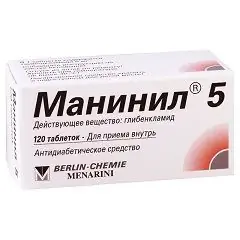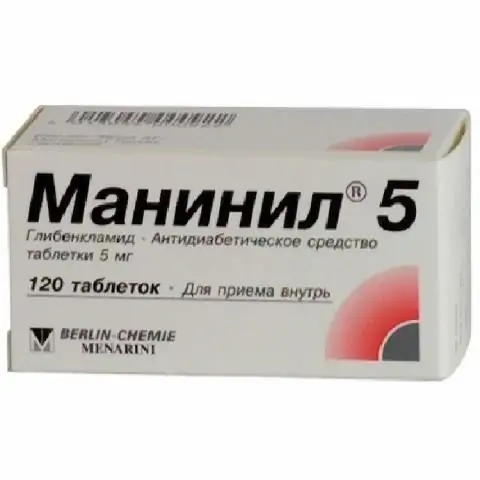- Author Rachel Wainwright [email protected].
- Public 2023-12-15 07:39.
- Last modified 2025-11-02 20:14.
Maninil 5
Latin name: Maninil 5
ATX code: A10BB01
Active ingredient: glibenclamide (Glibenclamide)
Producers: Berlin-Chemie, AG (Berlin-Chemie, AG) (Germany); Menarini-Von Heyden, GmbH (Germany)
Description and photo update: 2020-18-08
Prices in pharmacies: from 81 rubles.
Buy

Maninil 5 is a hypoglycemic drug for oral use from the group of PSM (sulfonylurea derivatives) of the II generation.
Release form and composition
Dosage form - tablets: flat-cylindrical, beveled, color from pale pink to pink, on one side there is a dividing line (120 pcs. In transparent glass bottles, in a cardboard box 1 bottle and instructions for use of Maninil 5).
Composition for 1 tablet:
- active substance: glibenclamide - 5 mg;
- auxiliary components: lactose monohydrate - 90 mg; potato starch - 48.697 mg; magnesium stearate - 1.5 mg; talc - 2.25 mg; gelatin - 2.55 mg; crimson dye E124 (Ponso 4R) - 0.003 mg.
Pharmacological properties
Pharmacodynamics
Maninil is a micronized, high-tech, specially milled form of glibenclamide, which optimizes the pharmacokinetic and pharmacodynamic profile of the hypoglycemic agent.
Glibenclamide induces insulin secretion by lowering the irritation threshold of pancreatic β-cells by glucose, increases insulin sensitivity and the level of its binding to target cells, increases the release of endogenous insulin, enhances the effect of insulin on glucose absorption by muscle tissue and liver, inhibits adipose tissue breakdown under the action of lipase on fatty acids. It acts in the second phase of insulin secretion, exhibits a lipid-lowering effect, and reduces the thrombogenic potential of the blood.
The hypoglycemic activity of glibenclamide develops 2 hours after oral administration and, depending on the dose taken, can last up to 24 hours.
The micronized form of Maninil 5 allows you to quickly reach the maximum concentration (C max) of glibenclamide in blood plasma. As a result, the hypoglycemic effect of the drug practically corresponds to the extreme development of postprandial hyperglycemia, which, in combination with a shortened half-life (T 1/2), provides a physiological process and reduces the risk of hypoglycemia. At the same time, the patient's daily requirement for glibenclamide may decrease by 30-40%.
Pharmacokinetics
When taken orally, glibenclamide in micronized form is rapidly absorbed in the digestive tract, which makes it possible to take Maninil 5 tablets immediately before meals. The bioavailability of the substance when taken in micronized forms is 100%. T Cmax (time to reach C max) is 2.5 hours.
Glibenclamide binds to blood plasma proteins at a level of 98%. It is biotransformed completely in the liver, as a result, two inactive metabolites are formed, one of which is subject to renal elimination, the other is excreted in the bile. After oral administration, T 1/2 is from 3 to 10 hours, on average about 7 hours. The pharmacological action of the drug lasts more than 12 hours.
In case of impaired liver function, the excretion of glibenclamide from the plasma slows down, in patients with renal failure, the excretion of metabolites in the bile increases compensatory. If the CC (creatinine clearance) is higher than 30 ml / min, then the total excretion does not change, but in patients with severe renal failure, glibenclamide may accumulate.
Indications for use
Maninil 5 is used as a monotherapy drug or as part of a combination treatment with other oral hypoglycemic agents for oral administration (except for other PSM and glinides) for the treatment of type 2 diabetes mellitus.
Contraindications
Absolute:
- type 1 diabetes mellitus;
- diabetic ketoacidosis, diabetic precoma / coma;
- condition after removal of the pancreas;
- severe liver failure;
- severe renal failure with CC less than 30 ml / min;
- some emergency conditions when insulin therapy is needed, such as decompensation of carbohydrate metabolism in burns, injuries, infectious diseases, or after major surgical interventions;
- intestinal obstruction, paralytic intestinal obstruction;
- leukopenia;
- genetically determined lactose intolerance, lactase deficiency, glucose-galactose malabsorption syndrome;
- lack of G6PD (glucose-6-phosphate dehydrogenase);
- pregnancy and the period of breastfeeding;
- children and adolescents up to 18 years old;
- individual hypersensitivity to the rest of the PSM, sulfonamides, diuretics (diuretics) with a sulfonamide group in the molecule, probenecid, since there is a high probability of developing cross-allergic reactions;
- established hypersensitivity to glibenclamide, as well as other components in the composition of the tablets.
With caution, under the supervision of a specialist, Maninil 5 is recommended for patients with thyroid dysfunction, febrile syndrome, cerebral atherosclerosis, hypofunction of the adrenal cortex or anterior pituitary gland, chronic alcoholism, acute alcohol intoxication, in old age (over 70 years) (due to with the risk of hypoglycemia), as well as in conditions accompanied by impaired absorption of food and the appearance of hypoglycemia.
Maninil 5, instructions for use: method and dosage
Maninil 5 tablets are intended for oral administration. They need to be swallowed whole or in half, without chewing and drinking a small amount of liquid, 20-30 minutes before meals.
The dose of the drug is prescribed taking into account the severity of diabetes, the patient's age, fasting blood glucose and 2 hours after eating.
The starting daily dose of glibenclamide is usually 2.5 or 5 mg (0.5 or 1 tablet) and is taken at a time.
If the administration of Maninil 5 in the initial dose does not provide adequate metabolic control, it is gradually increased under strict medical supervision. The dose is increased at intervals from several days to 1 week until the desired clinical effect is obtained, provided that the achieved dose does not exceed the maximum. The daily therapeutic dose ranges from 2.5 to 15 mg. A maximum of 3 tablets of Maninil 5 (15 mg glibenclamide) are allowed per day.
Daily doses of up to 2 tablets are taken at a time, in the morning before breakfast. Maninil 5 in the amount of 3 tablets per day is divided into 2 doses: in the morning - 2 pcs., In the evening - 1 pc.
Skipping the next dose at a certain time is not compensated, the next pill is taken at the set time in the prescribed dose, which should not be increased.
Elderly, weakened, severely impaired renal and / or liver patients or patients with reduced nutrition should receive Maninil 5 in a reduced dose, due to the risk of hypoglycemia.
The transition to Maninil 5 from other hypoglycemic agents is carried out under the supervision of a physician from 0.5 or 1 tablet per day (2.5 or 5 mg glibenclamide), gradually increasing the dose until the required clinical effect is obtained, provided that the achieved dose does not exceed the maximum allowable …
Side effects
With the use of Maninil 5, the following side effects may develop [gradation in descending frequency of occurrence: often (> 0.01, but 0.001, but 0.0001, but <0.001), extremely rare (<0.0001, including single messages)]:
- metabolism and nutrition: often - hypoglycemia, the symptoms of which may be headache, hunger, tachycardia, pyrexia, drowsiness, skin moisture, weakness, impaired coordination of movements, general anxiety, tremors, fear, transient neurological disorders (such as vision and speech, the appearance of paresis / paralysis, allopsychic depersonalization); increase in body weight;
- digestive tract: infrequently - a feeling of heaviness in the stomach, abdominal pain, nausea, belching, vomiting, metallic taste in the mouth, diarrhea;
- hepatobiliary system: extremely rarely - intrahepatic cholestasis, transient increase in the activity of liver enzymes, hepatitis;
- immune system: infrequently - itching, purpura, petechiae, urticaria, increased photosensitivity; extremely rare - allergic vasculitis; generalized hypersensitivity reactions, accompanied by arthralgia, skin rash, fever, jaundice, proteinuria; anaphylactic shock;
- blood and lymphatic system: rarely - thrombocytopenia; extremely rarely - agranulocytosis, leukopenia, erythropenia; extremely rare - pancytopenia, hemolytic anemia;
- other reactions: extremely rarely - visual impairment / accommodation disorders, transient proteinuria, hyponatremia, increased urine output, antabuse effect or disulfiram-like reaction, develops while taking Maninil 5 with alcohol [characteristic signs are abdominal pain, nausea, vomiting, feeling of blood rush (heat) to the skin of the face and upper body, dizziness, headache, tachycardia]; cross-hypersensitivity to probenecid, other PSM, sulfonamides, diuretics (diuretics) with a sulfonamide group in the molecule.
Overdose
A symptom of an overdose of glibenclamide is hypoglycemia, signs of which may be headache, hunger, tachycardia, hyperthermia, drowsiness, skin moisture, weakness, impaired coordination of movements, general anxiety, tremors, fear, transient neurological disorders (such as visual and speech disorders, the appearance of paresis / paralysis, allopsychic depersonalization). The progression of hypoglycemia can lead to a loss of self-control / consciousness in patients and the development of hypoglycemic coma.
For the treatment of mild hypoglycemia, you need to eat a piece of sugar, food or drinks with a high glucose content (honey, jam, a glass of sweet tea).
In case of loss of consciousness, glucose is administered intravenously in the form of a 40% dextrose / glucose solution at a dose of 40 to 80 ml, then a 5-10% dextrose solution is infused. Thereafter, an additional 1 mg of glucagon can be administered intravenously, subcutaneously or intramuscularly. If the patient has not regained consciousness, the procedure is repeated. In especially difficult cases, a complex of therapeutic measures may be required to restore normal body function (intensive therapy).
special instructions
You need to take Maninil 5 tablets strictly following the recommendations of an endocrinologist, observing the diet prescribed by him and independently controlling the concentration of glucose in the blood.
With prolonged abstinence from food, insufficient intake of carbohydrates, intense physical activity, diarrhea or vomiting, the risk of hypoglycemia increases significantly.
Simultaneous administration of drugs that affect the function of the central nervous system, lowering blood pressure (including β-blockers), as well as diabetic autonomic neuropathy, can mask the symptoms of hypoglycemia.
Since the likelihood of developing hypoglycemia in elderly patients is slightly higher, they need to more carefully select the dose of glibenclamide and regularly monitor blood glucose levels both on an empty stomach and after meals, especially at the beginning of therapy.
Alcohol consumption during the treatment of diabetes mellitus can cause the development of hypoglycemia and disulfiram-like reactions (antabuse effect), the symptoms of which are abdominal pain, nausea, vomiting, a feeling of blood flow (heat) to the skin of the face and upper body, tachycardia, dizziness, headache … In this regard, it is recommended to refrain from drinking alcohol while taking Maninil 5.
With extensive surgical interventions and injuries, infectious lesions with a febrile syndrome, deep extensive burns, it may be necessary to cancel oral hypoglycemic agents and switch to parenteral insulin administration.
Patients taking Maninil 5 tablets are not recommended to stay in the open sun for a long time.
Influence on the ability to drive vehicles and complex mechanisms
Considering the risk of hypoglycemia developing while taking glibenclamide, as well as possible side reactions of Maninil 5 in the form of visual impairment or accommodation disorder, care must be taken when driving and servicing other complex, potentially dangerous mechanisms.
Application during pregnancy and lactation
Maninil 5 is contraindicated for the treatment of pregnant and breastfeeding women. In case of pregnancy, therapy must be discontinued.
Pediatric use
In pediatric practice, Maninil 5 tablets are not used for the treatment of children and adolescents under 18 years of age, since there are no data confirming the efficacy and safety of glibenclamide in this age group.
With impaired renal function
It is contraindicated to take Maninil 5 patients with severe renal failure (CC less than 30 ml / min).
For violations of liver function
It is contraindicated to take Maninil 5 patients with severe hepatic impairment.
Use in the elderly
Maninil 5 is prescribed with caution to elderly patients over 70 years of age due to the fact that they are more likely to develop hypoglycemia.
Drug interactions
- angiotensin-converting enzyme inhibitors, anabolic agents and male sex hormones, other oral hypoglycemic agents (such as acarbose or biguanides) and insulin, azapropazone, non-steroidal anti-inflammatory drugs, β-adrenergic blockers, quinolone derivatives, chloramphenium and cloramphenicol derivatives, disopyramide, fenfluramine, antifungal drugs (miconazole, fluconazole), fluoxetine, monoamine oxidase inhibitors, paraaminosalicylic acid, pentoxifylline (with parenteral administration of high doses), perhexiline, pyrazolone derivatives, phosphamides, probesfamides, probosfamides, probosfamides, probosfamides, probosfamides, tetracyclines and tritoqualin: when taken simultaneously with Maninil 5, they can enhance its hypoglycemic effect;
- drugs that acidify urine (ammonium chloride, calcium chloride): reducing the degree of dissociation and increasing the reabsorption of glibenclamide, enhance the pharmacological action of Maninil 5;
- barbiturates, isoniazid, diazoxide, glucocorticoids, glucagon, nicotinates (in high doses), phenothiazines, phenytoin, rifampicin, acetazolamide, thiazide diuretics, oral contraceptives and estrogens, preparations of iodine-containing hormones of the thyroid gland sympatoms, thyroid-mediated channel salts, blockers simultaneous use with the drug Maninil 5 is able to reduce the hypoglycemic effect of glibenclamide;
- blockers of histamine H 2 -receptors: on the one hand, they can weaken and, on the other hand, enhance the hypoglycemic effect of Maninil 5;
- pentamidine: in isolated cases, it causes a strong decrease or increase in the concentration of glucose in the blood;
- coumarin derivatives: glibenclamide is able to enhance or weaken their effectiveness;
- β-blockers (guanethidine, clonidine, reserpine), as well as drugs with a central mechanism of action: they increase the hypoglycemic effect of glibenclamide, along with this weaken the sensation of symptoms-precursors of hypoglycemia.
Analogs
Analogues of Maninil 5 are Glibenclamide, Glidiab, Glidiab MV, Gliclada, Gliclazide MV, Gliclazid MV Pharmstandard, Gliclazide MV-Vertex, Gliclazid-SZ, Glyurenorm, Golda MV, Diabetalong, Diabeton MV, Diabefarm, Diabinfax Stalm MV, Diabeton and Stalin dr.
Terms and conditions of storage
Store at temperatures up to 30 ° С out of the reach of children.
The shelf life is 3 years.
Terms of dispensing from pharmacies
Dispensed by prescription.
Reviews about Maninil 5
Reviews of Maninil 5 from endocrinologists are quite diverse. Some experts consider it to be an old proven antidiabetic agent, which has proven itself only on the positive side, characterized by a quick and effective relief of glycemia. Active absorption from the digestive tract provides a high therapeutic effect of glibenclamide. Indicate that adverse reactions are extremely rare and mainly depend on the individual characteristics of patients.
Other doctors choose not to prescribe Maninil 5, because it causes hypoglycemia, increases appetite, which can lead to weight gain and increase insulin resistance, bringing patients closer to possible insulin therapy. Currently, new drugs have been developed for the treatment of diabetics, which are more effective and with fewer side effects. Such specialists use PSM only in the absence of a choice, with a strict individual selection of the dose, in order to reduce the likelihood of adverse reactions.
Patients are also controversial in their assessment of the drug. It helps many people well, even with a long course of therapy of several years or more, but subject to strict adherence to the prescribed diet and constant monitoring of blood sugar levels, which ensures almost complete absence of side effects. Some reviews describe a deterioration in well-being and side reactions in the form of headaches, weakness, sweating of the palms. All are unanimous in assessing the cost of the drug and call it inexpensive, budgetary or affordable.
Price for Maninil 5 in pharmacies
Estimated price of Maninil 5, 5 mg tablets, 120 pcs. in a glass bottle - from 81.5 to 126 rubles; 20 pcs. in blisters, in a cardboard box 6 blisters (120 pcs.) - 106 rubles.
Maninil 5: prices in online pharmacies
|
Drug name Price Pharmacy |
|
Maninil 5 5 mg tablets 120 pcs. RUB 81 Buy |
|
Maninil 5 tablets 5mg 120 pcs. RUB 105 Buy |

Maria Kulkes Medical journalist About the author
Education: First Moscow State Medical University named after I. M. Sechenov, specialty "General Medicine".
Information about the drug is generalized, provided for informational purposes only and does not replace the official instructions. Self-medication is hazardous to health!






